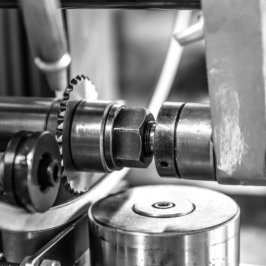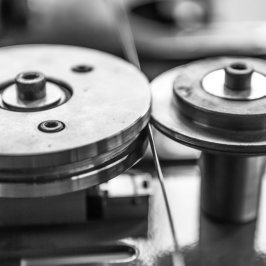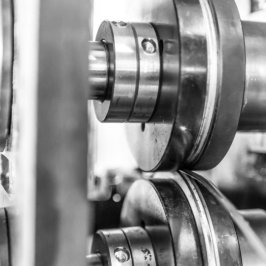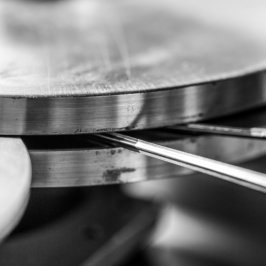

USEFUL INFORMATION ON GASKETS
Learn more about gaskets, the different deployment and application possibilities as well as, which materials our gaskets are made from. Flat gaskets are mainly installed as a static sealing element between two flanges. The choice of a different material can be made depending on the different conditions of deployment such as temperature, pressure and media (e.g. liquids or gases). In the case of the lower temperature range up to 100 °C and pressures of up to 40 bar, simple flat gaskets made of elastomers (rubber), fibre composites (e.g. aramid fibre with NBR), polytetrafluoroethylene (PTFE) and graphite are mostly used. At higher pressures and / or temperatures, the choice of the type of gasket is much more difficult and also depends on the temperature / pressure combination as well as the application media. A fibre composite gasket made of aramid fibre and NBR can for example be used in connection with the media air up to 300 °C, but fails in the case of water vapour already at 110 °C. Graphite is thereby much more flexible since it can be deployed in the temperature range from approximately -200 °C to approximately + 450 °C. Another criterion for the use of gaskets is the pressure. At pressures above 40 bar, flat gaskets for example, significantly reach their limits. Spiral-wound gaskets or comb profile gaskets are as a consequence deployed at high pressures. These two types of gaskets are very suitable for pressure ranges from a few bar to up to 400 bar; in tested individual cases even significantly higher. Spiral-wound gaskets and comb profile gaskets are concomitantly deployed in composite with graphite inserts or supports in the aforementioned pressure range, in the case of temperatures between -200 °C and 450 °C. Decisive for the use of spiral-wound gaskets or comb profile gaskets is the combination of materials used in connection with the construction of the gaskets and flanges.Information about spiral-wound gaskets
Spiral wound gaskets are account of their elasticity (albeit low) better suited for flange connections with slight movements and / or vibrations, than grooved gaskets. Spiral-wound gaskets and grooved gaskets are mainly deployed in composite with mica inserts or support at temperatures between 450 °C and 1000 °C. It is important to note that the pressure limit in the case of the composite with mica at most only amounts to less than 40 bar. In the event that Inconel 625 or 1.4828 is used in composite with V4A, the temperature upper limit is 800°C In the case of the spiral-wound gaskets, a V-shaped profiled metal strip is wound from different metallic materials, whereby a filler-band made of expanded graphite or PTFE is integrated in the winding. This V-shaped cross section effects the improvement of the resilience properties of the spiral-wound gaskets. We supply all the spiral-wound gaskets depending on the scope of application with and without inner and outer rings. This in principle makes a universal application possible and substances such as water, bases, steam, acids and gases can be easily sealed. The many benefits of spiral-wound gaskets can be identified in conventional and nuclear-fired power plants, chemical and petrochemical plants, refineries, in apparatus and boiler construction, high-pressure piping with flange connections, in the pulp and paper production as well as in aerospace applications. We offer all the spiral-wound gaskets with and without inner and outer rings. In case you require particularly chemical-resistant variants of our spiral-wound gaskets, we are happy to present to you our individually tailored solutions.Information about comb profile gaskets
The comb profile gasket is one of the technical standards, in particular in power and nuclear power plants. They are deployed among others as a heat exchanger sealing, in the case of flange sealing as well as in the case of lids for fittings in the steam cycle. The sealing surface of the metal core consists of a 90° profiled sealing surface, on which a soft material support is installed. The latter consists exclusively of high-quality materials, such as graphite or PTFE. The comb profile gaskets can seal virtually all media, which is due to the selection of exclusively first-class carrier materials and sealing support. The enormous advantage of the comb profiled gasket is the interplay of low minimum surface pressure and high permissible maximum surface pressure. This characteristic permits a large range of applications. this gasket is as such not only deployed for the sealing of steam, water, alkalis, organic and inorganic gases, aliphatic and aromatic hydrocarbons, alcohols, ethers, ketones, but particularly also in the case of many other chemical substances. The application temperatures are from -200 °C up to +1000 °C. In addition, the comb profiled gaskets can without a problem be used to reliably master a total pressure of up to 400 bar. The comb profiled gaskets from our assortment can be used for all standardised flanges from DN 10 up to DN 3600. In case you need special forms, we can of course also offer tailored solutions, which are also distinguished by a high degree of quality.Information about ring joint gaskets
Ring joint gaskets are deployed wherever pipes and fittings are not only exposed to enormously high pressures, but must also have to withstand extreme temperatures. Ring joint gaskets are regarded to count among the most reliable and highest-quality metallic gaskets, available. They are in particular deployed in the petrochemical industry, in power plants, in the oil and gas industry as well as in the offshore sector. Ring joint gaskets, can withstand temperatures of up to 1,000 °C as well as a total pressure of approximately 1,300 bar. Ring joint gaskets are inserted into the trapezoidal groove of the flanges. As a result, the bolt load can be concentrated exclusively on a small area. It is e.g. also of utmost importance that the ring material itself always exhibits a softer texture as that of the pair of flanges. The compression of the ring joint gasket results in a material flow in the rings at the contact surfaces to the flanges, which in turn leads to the sealing effect. Our assortment features not only oval and octagonal ring joint gaskets, but also a wide range of special shapes. We deliver according to our standard materials or tailored to your specifications.Information about lens gaskets
Lens gaskets are likewise characterised by a number of advantages. Particularly the fact that this form of gasket is insensitive to over-pressing likewise makes it highly attractive for several industrial sectors. This property is achieved on account of the fact that the surface between the spherical flange and the spherical lens-gasket increases in the case of stronger pressure. On account of this effect the pressing value is only under proportionally increased on this surface. This sealing effect leads to a so-called elastic deformation of the respective contact surfaces, on account of which a further advantage results: lens gaskets can as such be used several times! In addition to the standard gaskets, we also offer in our assortment special forms of the lens-spectacle blind gaskets as well as bellow lenses.Information about corrugated gaskets
There are different variants of corrugated gaskets. On one hand, they differ in form, so that both round as well as oval rings and elongated rings with bridges or various straps also exist. On the other hand, there are corrugated gaskets with and without support. The enormous variation of this form of gasket means that it can be put to use in many different areas. Corrugated gaskets (including torque support) are in particular deployed wherever flexurally weak flanges are used. A distinction is thereby made among three basic variants: corrugated gaskets with sheet-like soft material support, corrugated gaskets with string supports or corrugated gaskets all-metal, also without support. We predominantly offer all three basic variants in our assortment that can where expedient all be supplied by us also in different variations.Information about flat metal gaskets
Flat metal gaskets are deployed wherever the use of other gaskets is not possible due to extreme basic conditions. Factors that necessitate the use of flat metal gaskets are for example, special temperature- and pressure values or else a leak rate that renders the deployment of soft material gaskets and metallic soft material gaskets impossible. The thickness of the flat metal gaskets differs, depending on the texture of the flange or the conditions of deployment. Insofar as the surface finish as well as the smoothness of the flanges is particularly good, a relatively thin flat gasket can be used. The variance for example amounts to 2 to 3 mm in the case of heat exchangers or 0.5 to 1 mm in the case of spinnerets sticks. Flat metal gaskets are where expedient produced from different metals depending on the scope of application. We can offer flat gaskets made of different metals from our assortment that are tailored to your needs.Information about rubber-steel gaskets
Rubber-steel gaskets are mainly used for the sealing of gas, water, acids and alkalis, air as well as hydrocarbons. Although they can be used only in the case of comparatively low temperatures of up to 200 °C and only low pressure conditions, rubber-steel gaskets are however distinguished by a number of advantages. They consist of a steel ring that is coated with rubber (caoutchouc). A rubber-steel gasket is as such not only resistant to corrosion, but also media protected. The optimal scope of application of rubber-steel gaskets can be found wherever effective sealing of comparatively cool substances with enormously low leakage rates, coupled with low screw connection forces is necessary. The internal steel ring prevents the gasket from being squeezed out by the prevailing pressure.Information about pure graphite gaskets
Pure graphite gaskets are widely used in all industrial sectors. They are among others found wherever enormously high temperatures can also be found or substances that are distinguished by a special aggressiveness. Pure graphite gaskets are thus especially deployed in the manufacture of pumps and / or exhaust systems. The mutability of these gaskets particularly makes them attractive for many areas. Pure graphite gaskets can for example be supplemented with stainless steel flaps or be impregnated with PTFE or copper, in order to achieve better results and an optimal application. On account of the impregnation graphite foil, can also be deployed in the case of temperatures that exceed 450 °C.Information about soft material gaskets
Soft material gaskets belong to the exclusive gasket types. They are characterised by excellent heat resistance, whereby different temperature-maximum values can be reached. They are all the more different, because soft material gaskets are characterised by the use of different materials (as required). Soft material gaskets have an inner core, which is usually made of aramid or ceramic fibres, PTFE or graphite. Soft material gaskets are used wherever increased over-pressing prevails. This is counteracted by a chamber system in the interior of the gasket, which is filled with the soft materials. The different combinations of metal and soft materials can be requested from us.
Apollon InduTec GmbH
Kurt-A.-Körber-Chaussee 73 - Halle J | 21033 Hamburg | Germany
Telefon +49 (0)40 237 67 13 - 10 | Fax +49 (0)40 361 661 53
info@apollon-indutec.de

ENGLISH

DEUTSCH

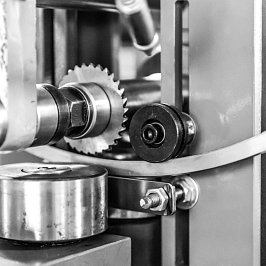






Juni 2021 | Design, Grafik, Texte, Fotos, Inhalte: plattfisch.tv brautfisch.tv












































































